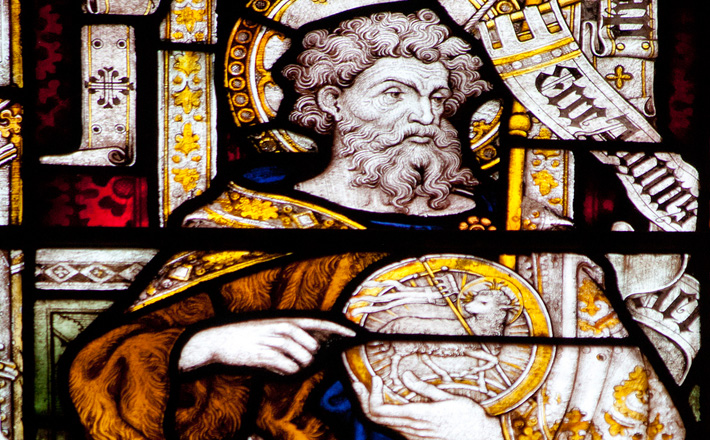Commentary on John 1:29-42
So, Jesus is the Lamb of God. What does this mean?
So, this lamb of God takes away the sin of the cosmos. What does that mean?
The history of interpretation provides a squad of confident answers to these little questions. The problem is, the answers aren’t persuasive. This is a problem.
For one thing, what is a “lamb of God?” That should be simple, I suppose, but it’s not. Does the lamb belong to God, or come from God, or possess some sort of godly status? All of those are possible readings of the Greek. If the lamb belongs to God, then what is its purpose? Is it one of the larger flock? John the Baptist seems to argue against such a reading.
Is it God’s Passover lamb? The storyteller does link Jesus’ death with the slaughter of the Passover lambs, but why would God need a Passover lamb? The rabbis imagine that God joins in the observance of the religious rhythm of the world, so maybe God eats Passover, too. But if Jesus is God’s Passover lamb, that requires us to imagine God roasting and eating a human being. Even figuratively, this is a problem.
Of course, the business of taking away sin might simplify things. Or not. Lambs are part of the sacrificial system, but not as “sin offerings.” Lambs are generally mentioned as a “whole burnt offering” that is distinguished from the sin offering. And the times when lambs ARE mentioned as sin offerings, they are females a year old, which puts them on the borderline between lamb and sheep. And they are female.
Male goats are mentioned, but male lambs seem to be left out, at least where “sin offerings” are concerned. So maybe the storyteller doesn’t know this? Or maybe John is saying that Jesus is the female lamb of God. And maybe, since it’s just symbolic, gender doesn’t matter? Or maybe gender does indeed matter and John is cross-identifying Jesus? Or maybe there is sacrificial practice that we just don’t know about?
All of these are real possibilities, but not one is altogether satisfying. And we have not yet considered the matter of taking away the sin of the cosmos by means of any creature, adult or juvenile, ungulate or human. How would that work? Maybe it’s all figurative, or mystical, or spiritual, or something. Still not satisfying, if only because the whole notion of the efficacy of blood sacrifice is no longer knit into the fabric of most people’s universe.
To my eye, the most interesting interpretive line ties the scene to another time a human being was linked to a sheep, in Genesis 22. Isaac notices the fire and the knife, but asks about the lamb. The word he uses (when he speaks Greek in the Septuagint) is different: probaton instead of amnos (and it’s even more complicated in Hebrew, where the word is better translated as “sheep” since it implies nothing about age, indicating only that the animal is one of the flock), and there is no suggestion that the offering God commanded Abraham to perform had anything to do with taking away sin, but when Abraham answers he says, “God himself will provide the lamb for a burnt offering, my son” (Genesis 22:8). Everett Fox notes that a translator might choose to use a dash rather than a comma at this point (“God himself will provide the lamb for a burnt offering — my son”) to capture in English the irony of the Hebrew sentence.1
What matters, I think, is that the phrase “lamb of God” does not point easily and simply to a single symbolic referent. Rather, it weaves this chance encounter with Jesus into the whole variegated tapestry of Jewish Scripture.
The lamb is eaten, even as Jesus indicates in John that gnawing on his corpse is required in order to have life (John 6:54, where the verb that the NRSV timidly translates as “eat” is trogo, which means animalistic gnawing).
The lamb is burned as a whole burnt offering, not for sin but simply for extravagant sacrifice, which puts the one who offers the sacrifice (of the future of his flock) in the position of having to rely completely on God.
The lamb is the long-awaited son, provided by God as part of a promise long-delayed, who walks with his father, the two of them together, on the way to the slaughter of the son and of the promise.
I think it matters that this links Jesus somehow to the sin of the cosmos. Even this linkage is not simple, no matter what millennia of atonement theories might suggest. For one thing, Jesus does not exactly “take away” the sin of the world, at least not in Greek. He lifts it up. Perhaps John means to suggest that, by lifting it up, he takes it away. This is possible. But it is also possible that by lifting it up he makes it visible so everyone can see it easily.
If this is what John means, he is linking this quick account of a random encounter to the story of the lifting up of the image of the fiery serpent in Numbers 21:9. When people bitten by poisonous snakes looked at the image, lifted up and easy to see, they were healed. John makes this linkage explicitly in chapter 3. Perhaps the storyteller expects the audience to see the same picture.
Or maybe the storyteller wants the audience to hear in airo, the verb for “lifting up,” the sense of emphasizing and making evident, even exaggerating. Such a reading would indicate that the lamb of God, in being thrown into the fiery torture of a Roman crucifixion, makes unmistakable the depth of human violence and sin. This would fit with Nils Dahl’s argument, now decades old, that the base story in Scripture (especially for Christians, but also for Jews) is the story of God’s endangered promises.2
This brings together many of the possibilities suggested by this odd little scene, and links the Jesus story tightly to the story of the binding of Isaac. Just as God’s promise of descendents and a future is brought into peril by God’s command to sacrifice the only son of Sarah and Abraham, so also God’s promise of the rectification of the world is called into question by the story of a messiah crucified by Rome. (As Paul points out to the Corinthians, the notion of a crucified messiah is either scandalous or moronic. Take your pick.)
Perhaps Roman sinfulness is simply too strong for God’s promises to be effective. This is a disturbing reflection, but it is one that people in every generation and every community have to consider. Invariably fatal diseases are still invariably fatal, and no amount of religious fervor changes that. Brutal dictators still gas and torture their own people, and no proclamation of the reign of God even slows them down. Pointless pain is still pointless even when people find a way to smile bravely as they ask for the morphine.
Perhaps one of our required reflections, we who confess that God’s messiah has come to a weary world “in sin and error pining,” must be on the adamant stubbornness of the pain of the world. This, also, is what a “theology of the cross” must meditate on.
Even so, Lord Jesus, quickly come.
1 Everett Fox, The Five Books of Moses (New York: Schocken Books, 1995.), 94n8.
2 See Nils Dahl, “The Crucified Messiah and the Endangered Promises,” in Jesus the Christ: Historical Origins of Christological Doctrine (Minneapolis: Fortress, 1991).


January 19, 2014